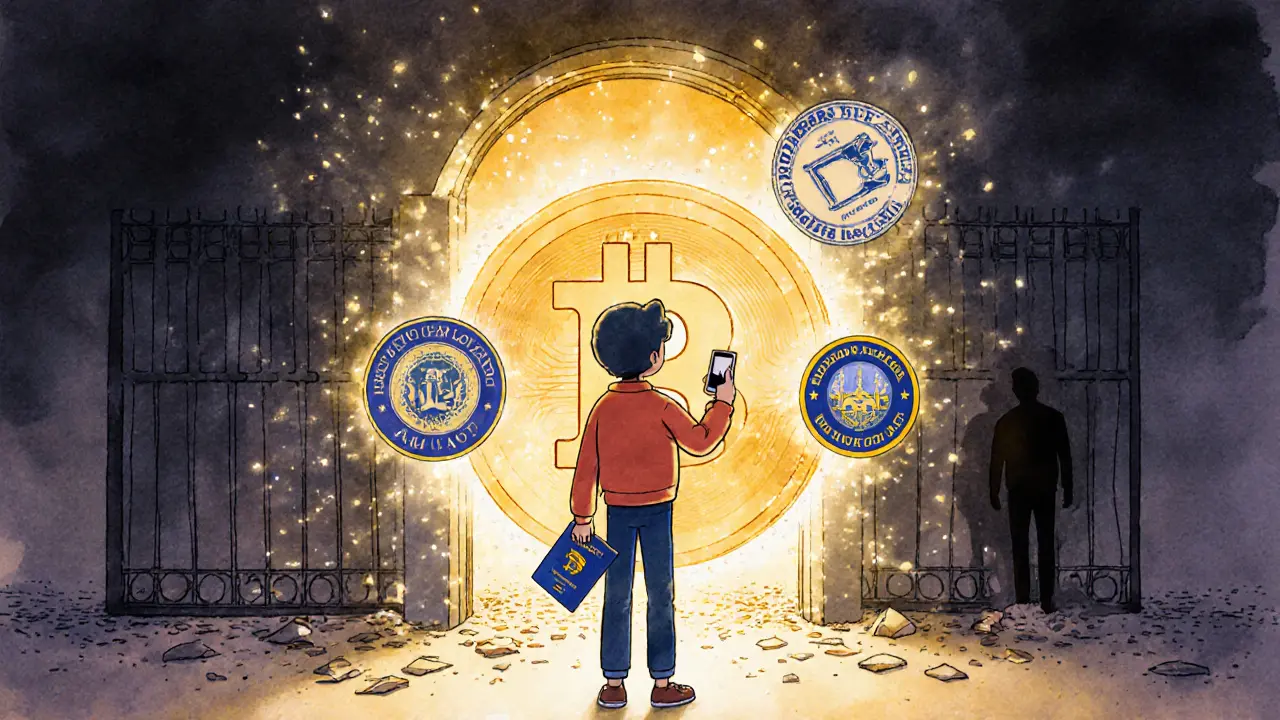Posted By Tristan Valehart On 12 Nov 2025 Comments (5)

KYC Verification Time Estimator
How long will your KYC take?
Estimate your verification time based on document quality and country of origin. Average verification time is 3.5 minutes with optimal conditions.
0
minutesEstimated verification time
Medium risk of delaysTips for Faster KYC
- Use a passport - it's the most widely accepted document
- Ensure your ID is valid and unexpired
- Take a clear photo with good lighting
- Match your selfie to your ID exactly (no glasses, hats, or angles)
- Prepare your utility bill or bank statement for address verification
When you sign up for a crypto exchange today, you’re not just creating an account-you’re walking through a digital gate that’s been locked shut by regulators. The days of anonymous Bitcoin trades with just an email and a password are over. As of 2025, KYC requirements on crypto exchanges are no longer optional. They’re the baseline. If a platform doesn’t verify your identity, it’s either illegal, risky, or both.
Why KYC Is No Longer Optional
KYC-Know Your Customer-isn’t new. Banks have used it for decades to stop money laundering and fraud. But crypto? It was built on the idea of being anonymous, decentralized, and free from banks. That changed in 2019 when the Financial Action Task Force (FATF) made it clear: virtual asset service providers (VASPs), including crypto exchanges, must follow the same AML/CFT rules as traditional financial institutions. By 2025, 92% of centralized crypto exchanges globally are fully compliant. That’s up from 85% just a year earlier. Why? Because regulators aren’t playing around anymore. In the U.S., the Bank Secrecy Act forces exchanges to collect and verify user data. In the EU, AMLD6 does the same. If you try to withdraw more than a few hundred dollars without passing KYC, you’ll hit a wall. Some platforms let you trade small amounts without verification, but anything meaningful-withdrawals, higher limits, margin trading-requires full ID checks. And it’s not just about avoiding fines. Exchanges that skip KYC are becoming ghosts. They vanish when regulators crack down. Users are catching on too. In the U.S., 58% of crypto users now prefer platforms that require KYC. Why? Because they feel safer. Institutional investors? 67% say strong KYC is a dealbreaker. If you’re running a crypto business, skipping KYC isn’t a shortcut-it’s suicide.What Exactly Does KYC Require?
It’s not just uploading a photo of your driver’s license. Modern KYC on crypto exchanges is a three-part system:- Identity Verification - Proving you’re who you say you are. This means a government-issued ID (passport, driver’s license, national ID) plus a live selfie that matches the photo on the ID. Some platforms use facial recognition tech to make sure you’re not using a photo or video to trick the system.
- AML and PEP Screening - Checking if you’re on any sanctions lists, involved in corruption, or linked to criminal activity. This happens automatically. Your name, date of birth, and address get run against global databases of Politically Exposed Persons (PEPs) and sanctioned entities. If you’re flagged, a human reviewer steps in.
- Wallet and Transaction Monitoring - Once you’re in, they keep watching. Your on-chain activity gets analyzed. Did you just receive funds from a known darknet market? Did your wallet interact with a mixer? That triggers alerts. Tools like Chainalysis and Elliptic help exchanges trace crypto flows back to real-world identities.
How Fast Is KYC Now?
Back in 2023, getting verified on a crypto exchange could take hours-or even days. If your ID was blurry, your address didn’t match, or you were from a high-risk country, you’d get stuck in manual review limbo. Today? Average verification time is 3.5 minutes. That’s thanks to AI and machine learning. Systems now auto-detect document fraud, match faces with near-perfect accuracy, and flag inconsistencies before a human even sees the file. Fuzzy matching algorithms catch misspelled names or altered documents without flooding compliance teams with false alarms. Platforms like Sumsub, KYC-Chain, and iProov have made this possible. They offer APIs that integrate directly into exchange apps. Users upload a photo, take a selfie, and get approved while waiting for their coffee. For most people, it’s smoother than signing up for a streaming service.What Users Actually Say About KYC
People have strong feelings about KYC. On one side, users praise the security. “I used to worry someone would hack my account and drain it,” says a user from Toronto. “Now I know they verified my identity. That makes me feel safer.” Another common win: trust. “I stopped using that anonymous exchange after my funds got frozen for no reason,” says a trader in Berlin. “The KYC ones feel legit. I can actually call support.” But complaints are real too. Privacy is the big one. “Why does a crypto exchange need my passport and utility bill?” is a question you’ll hear often. Some users feel like they’re giving up too much. Others get stuck-especially if they’re from countries with less common ID formats, or if their documents are old or damaged. International users still face delays. A Nigerian user might get approved in minutes. Someone from Venezuela or Syria might wait days because their ID isn’t in the system. That’s a real flaw in the current model. The tech works great for passports from the U.S., EU, or Japan. It’s still catching up everywhere else.The Risks of Skipping KYC
You might think, “I’ll just use an unregulated exchange.” But here’s the truth: those platforms are dangerous. Without KYC, exchanges become magnets for criminals. Money laundering, ransomware payments, scam tokens-all flow through them. And when regulators shut them down, your funds disappear with them. In 2024, over $1.2 billion in crypto was lost from unregulated platforms that got raided or frozen. There’s also the trust factor. No institution, no bank, no hedge fund will work with an exchange that doesn’t do KYC. If you’re trying to move large sums or connect to DeFi protocols, you’ll hit a brick wall. Even some wallets now require KYC to interact with certain dApps. And don’t forget the legal risk. In many countries, using an unregulated exchange is technically illegal. You could be held liable if funds you received were traced to a crime-even if you didn’t know it.
What’s Next for KYC in Crypto?
The next phase isn’t just about doing KYC better-it’s about doing it everywhere. Right now, most DeFi platforms still don’t require KYC. But that’s changing. In 2024, only 25% of DeFi protocols offered optional KYC. By 2025, that jumped to 41%. Regulators are pushing hard to close this loophole. Expect mandatory KYC for DeFi aggregators, lending protocols, and even DEXs that handle large volumes. New tech is coming too. Privacy-preserving verification methods are being tested-like zero-knowledge proofs-that let you prove you’re over 18 or not on a sanctions list without revealing your name or ID. Some exchanges are already piloting these. Standardized international KYC data sharing is also on the horizon. Imagine one verified identity that works across exchanges in the EU, U.S., and Asia. That’s the goal. It’s not here yet, but the pieces are being built.Bottom Line: KYC Is the New Normal
Crypto didn’t kill banks. But it forced them to evolve. And now, crypto is being forced to evolve too. KYC isn’t a betrayal of decentralization-it’s the price of legitimacy. The industry’s survival depends on it. If you’re new to crypto, don’t fight KYC. Embrace it. The fastest, safest, most reliable platforms are the ones that do it well. If you’re running a platform, invest in a solid KYC solution. Don’t cut corners. Your users, your partners, and your future depend on it.Is KYC mandatory on all crypto exchanges?
No, not technically on every single platform-but on nearly all reputable ones. Centralized exchanges in the U.S., EU, UK, Australia, and most major economies are legally required to enforce KYC. Some smaller or offshore exchanges still operate without it, but they’re high-risk, often unregulated, and prone to shutdowns. If you want to trade, withdraw, or use institutional services, you’ll need to go through KYC.
Can I trade crypto without KYC?
Yes, but only in limited ways. Some exchanges let you buy small amounts (under $100-$500) without ID. Peer-to-peer platforms like LocalBitcoins or Paxful let you trade directly with others without KYC. But you can’t withdraw to a bank, use advanced trading features, or connect to most DeFi apps without verified identity. Trading without KYC means you’re stuck in a low-limit, high-risk bubble.
How long does KYC take on crypto exchanges?
For most users, it takes under 5 minutes. AI-powered systems verify IDs, match selfies, and confirm addresses automatically. If your documents are clear and you’re from a supported country, approval is instant. Delays happen if your ID is blurry, expired, or from a country with less common documentation. In those cases, manual review can take 1-3 business days.
Why do I need to submit my address proof?
Address verification helps prevent fraud and ensures you’re not using a fake identity. Regulators require exchanges to confirm where you live to comply with local AML laws. A utility bill, bank statement, or government letter dated within the last 3 months is typically accepted. This step helps tie your real-world identity to your crypto activity.
Is my KYC data safe on crypto exchanges?
Reputable exchanges store your data securely using encryption and strict access controls. Many use third-party KYC providers like Sumsub or KYC-Chain, which specialize in secure identity management. Your documents aren’t stored on the blockchain-they’re kept in encrypted, compliant databases. That said, no system is 100% hack-proof. Always choose exchanges with strong security track records and two-factor authentication enabled.
Will DeFi platforms require KYC in the future?
Yes, increasingly so. While most DeFi apps still don’t require KYC, regulators are targeting them. Protocols that handle large volumes, offer lending, or integrate with centralized services are already being pressured to add optional or mandatory KYC. By 2026, expect major DeFi platforms to implement some form of identity verification-especially if they want to partner with banks or institutional investors.
Can I use the same KYC verification on multiple exchanges?
Not directly-each exchange runs its own verification. But some platforms now offer “KYC portability” through third-party identity wallets. These let you store verified credentials (like your ID and address) in a secure digital wallet, then share them with exchanges without re-uploading documents. This is still new, but companies like Sovrin and Civic are building these systems. It’s the future of frictionless, reusable identity.
What happens if my KYC gets rejected?
You’ll usually get an email explaining why. Common reasons: blurry ID, mismatched name, expired document, or a name that matches a sanctions list. If it’s a simple error, you can resubmit with clearer documents. If you’re flagged for PEP or sanctions reasons, you may need to contact support with additional proof. In rare cases, exchanges may decline your application entirely-this is usually because of legal risk, not personal judgment.


Joy Whitenburg
November 13, 2025 AT 10:13Kylie Stavinoha
November 14, 2025 AT 05:53Diana Dodu
November 15, 2025 AT 14:26Raymond Day
November 15, 2025 AT 21:16Noriko Yashiro
November 17, 2025 AT 14:40